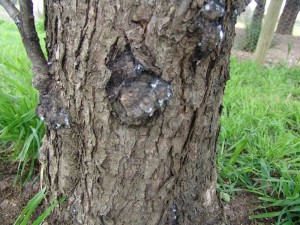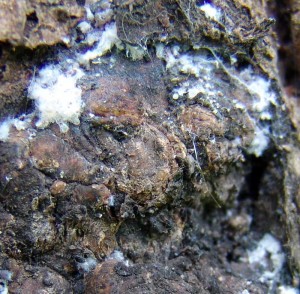Woolly aphids are sucking insects which can have a big impact on apple trees. They feed on leaves, buds, twigs, bark and roots causing twisted and curled leaves, yellowed foliage, poor plant growth, low plant vigor, and even dieback, particularly on already stressed trees.
 They become obvious with the appearance of fluffy, white deposits lower down on trunk and branches. However, they over-winter in the roots and at the base of the tree and visible infestations higher up are often just the tip of the iceberg.
They become obvious with the appearance of fluffy, white deposits lower down on trunk and branches. However, they over-winter in the roots and at the base of the tree and visible infestations higher up are often just the tip of the iceberg.
Healthy plants can withstand infestation although there will be some loss of vigour and production.
Woolly aphids also secrete honeydew, which is difficult to remove. While the honeydew itself is not a problem, it forms a substrate on which sooty mold can grow, which can block some of the sunlight needed for photosynthesis.
Control
The problem can be largely avoided by purchasing trees grown on woolly aphid resistant stocks – ask your supplier when choosing trees.
Some clonal stocks including M9 and M26 are quite prone to attack and may host large overwintering colonies, so they are best avoided for the home or organic gardener. Trees grown on traditional seedling stocks are also susceptible to attack.
 One of the best ways to manage woolly aphid (and many other pests) is by encouraging a diverse population of predators, including lacewings, lady beetles, hover flies and parasitic wasps. Even earwigs will help keep woolly aphid populations in check.
One of the best ways to manage woolly aphid (and many other pests) is by encouraging a diverse population of predators, including lacewings, lady beetles, hover flies and parasitic wasps. Even earwigs will help keep woolly aphid populations in check.
For natural predators to be most effective it is important to do everything to promote their growth and general biodiversity in the orchard or garden. This combined with good soil fertility through composting will also promote robustly healthy trees able to cope with minor infestations.
Remember, for predators to do their work there must be some of their food available, i.e. woolly aphid. Therefore over zealous use of sprays must be avoided.
Organic pesticides
The waxy coating on woolly aphids protects them from most organic sprays which are contact sprays, i.e. they must come into contact with a pest to kill it. The only effective way to kill the pest with contact sprays is direct application with a paint brush, rag or a stream of liquid that thoroughly drenches a colony. Even then some individuals may survive.
Methylated spirits or household bleach can be painted on to infestations with short term success. Colonies are likely to re-form again throughout the growing season. Regular applications during late autumn may help reduce the numbers surviving to over-winter.
Conventional pesticides
Far and away the most effective chemical control available to the home or small farm orchardist is Imidacloprid applied as a soil drench at petal fall. A common brand is Confidor, however, with the recent patent expiration of this chemical there are other brands available. It pays to shop around.
Correctly applied this can provide two seasons protection. It is important to wait until flowering is finished as Imidacloprid is highly toxic to bees.
Of course reliance on a single chemical almost always leads to the development of resistant populations so use another systemic pesticide such as dimethoate (Rogor) if the pest reappears during the control period and alternate preventative treatments with other suitable chemicals.
In the final analysis, unless you are quite comfortable using chemicals it is best to grow trees in a healthy, biologically diverse environment preferably grafted onto woolly aphid resistant rootstocks. These include Northern Spy, MM102 and MM106.
